Fraud or Fairytales: Russia and Ukraine's Electoral Experiences

Determining whether and to what extent fraud occurred in an election is "like a detective novel, or a crime scene investigation," according to Peter Ordeshook, Professor of Political Science, California Institute of Technology. "There's no one piece of data that clinches the case in some sense. It's the sum total of all the existing evidence, including the question of motive." At a 12 May 2005 Kennan Institute seminar, Ordeshook and Mikhail Myagkov, Associate Professor of Political Science, University of Oregon, argued that there is convincing evidence that the 2004 presidential elections in Russia and Ukraine were fraught with irregularities.
Ordeshook and Myagkov based their conclusions about Russian and Ukrainian elections on statistical analyses of regional- and district-level data on voter turnout and total votes for each candidate from national elections since 1996 in Russia, and since 1999 in Ukraine. Their analysis relies on the idea that voting in democratic societies normally follows certain expected patterns. Levels of voter turnout in all districts within a region are usually clustered in a normal distribution around the regional average; in districts with higher levels of voter turnout, each candidate should receive a higher number of total votes; and indicators such as voter turnout and support for a particular candidate or party do not generally change dramatically from one election to the next within a given region. Ordeshook and Myagkov argued that deviation from these patterns can be evidence of irregularities or fraud.
According to Myagkov, in 1996 and 2000, Russia's presidential elections appear to have been mostly normal (although there are noticeable irregularities in Russia's republics), without large deviations from expected patterns. However, "when we get to 2004, the whole picture falls apart," he said. Irregularities in the republics became more exaggerated, and the same irregularities appeared in many of Russia's oblasts. In 2004, he explained, a distinct division appeared between districts with normal voter turnout, and districts with unusually high voter turnout. In addition, districts with high voter turnout had more total votes for Vladmir Putin, but fewer than average for his opponents. Myagkov contended that "the high voter turnout was artificially created by essentially adding to the number of voters." Also worth noting, he argued, is the fact that there was no correlation between support for Putin in 2000 and 2004; Putin received more than 80 percent of the vote in 2004 in many districts where he had won less than 50 percent four years earlier.
Myagkov concluded that elections in Russia were marred by "abundant irregularities, which did not necessarily start in 2004, but probably the most alarming thing is that in the 2004 election, those irregularities increased exponentially." He estimated that Putin received 10-14 million suspect votes in the 2004 election.
Ordeshook argued that data from the second round of Ukraine's presidential elections in October 2004, which were widely criticized by international observers, demonstrate similar irregularities to those observed in Russia's 2004 election. The irregularities overwhelmingly favored "party of power" candidate Viktor Yanukovych. Ukrainian electoral districts, like Russian districts, were characterized by a division between those with normal voter turnout and those with high turnout. According to Ordeshook, in regions of Southern and Eastern Ukraine, Yanukovych benefited from the "excess" turnout, while Yushchenko benefited to a lesser extent in Western regions. While there were irregularities on both sides, they were on a very different scale. Ordeshook argued that Yushchenko received a maximum of 670,000 suspect votes, while Yanukovych received up to 3.8 million. He noted further that an inordinately large percentage of votes cast during the last few hours of the election went to Yanukovych, when, it appears, his supporters "panicked because they realized they were going to loose unless they did something about it."
A third round of presidential elections was held in December and described by numerous international observers as more democratic than the previous round. According to Ordeshook, electoral data from this round appears much closer to normal. There was little evidence of irregular votes in support of Yanukovych, and "there may have been some funny business still going on in the third round in favor of Yushchenko, but…certainly not anywhere near enough to swing the outcome of the election," he said.
Ordeshook argued that Ukraine's second and third rounds of presidential elections provided an ideal "lab" to test his and Myagkov's statistical analyses. The fact that the results of the analyses so closely corresponded with the conclusions of election observers is strong evidence that the analyses are accurate. He hopes that these tests, which rely on official election data, can be used to support the claims of on-the-ground observers, who are frequently accused of having political agendas. However, he cautioned that these tests are not intended to be a "black box" that can be used to detect electoral fraud in all political systems. Any researcher wishing to use statistical methods to evaluate elections, he argued, must have a very deep knowledge of the political system and electorate that they are studying in order to correctly identify irregularities. "There's just no substitute for understanding the political system itself," he emphasized.
Author

Kennan Institute
After more than 50 years as a vital part of the Wilson Center legacy, the Kennan Institute has become an independent think tank. You can find the current website for the Kennan Institute at kennaninstitute.org. Please look for future announcements about partnership activities between the Wilson Center and the Kennan Institute at Wilson Center Press Room. The Kennan Institute is the premier US center for advanced research on Eurasia and the oldest and largest regional program at the Woodrow Wilson International Center for Scholars. The Kennan Institute is committed to improving American understanding of Russia, Ukraine, Central Asia, the South Caucasus, and the surrounding region through research and exchange. Read more

Explore More
Browse Insights & Analysis
The OSCE is a Good Value for America

Infographic | Russia's Illegal Annexation of Crimea

Russia’s Indigenous Communities and the War in Ukraine
